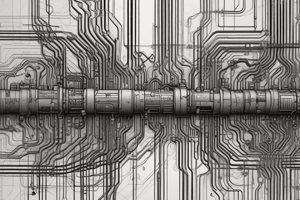Podcast
Questions and Answers
Flashcards
Total Current in Series vs Parallel
Total Current in Series vs Parallel
The total current in a parallel circuit is greater than in a series circuit.
Charging by Induction
Charging by Induction
Charging an object by rearranging its charges without direct contact.
Kirchhoff's Current Law (KCL)
Kirchhoff's Current Law (KCL)
The total current entering a junction equals the total current leaving.
Resistance and Length
Resistance and Length
Signup and view all the flashcards
Potential Difference in a Circuit
Potential Difference in a Circuit
Signup and view all the flashcards
Electric Field Basics
Electric Field Basics
Signup and view all the flashcards
Electric Flux through a Surface
Electric Flux through a Surface
Signup and view all the flashcards
Capacitance with Dielectric
Capacitance with Dielectric
Signup and view all the flashcards
Superposition Principle
Superposition Principle
Signup and view all the flashcards
Charge Transfer Calculation
Charge Transfer Calculation
Signup and view all the flashcards
Capacitors in Timing Circuits
Capacitors in Timing Circuits
Signup and view all the flashcards
Electric Field Direction for Positives
Electric Field Direction for Positives
Signup and view all the flashcards
Ohm's Law Relationship
Ohm's Law Relationship
Signup and view all the flashcards
Electric Potential Near Charges
Electric Potential Near Charges
Signup and view all the flashcards
Resistance and Area Relationship
Resistance and Area Relationship
Signup and view all the flashcards
Force between Charges
Force between Charges
Signup and view all the flashcards
Battery and Charge
Battery and Charge
Signup and view all the flashcards
Electric Field and Distance
Electric Field and Distance
Signup and view all the flashcards
Electric Field and Surface Area
Electric Field and Surface Area
Signup and view all the flashcards
Resistor Current Calculation
Resistor Current Calculation
Signup and view all the flashcards
Charge Conservation
Charge Conservation
Signup and view all the flashcards
Vector Addition of Forces
Vector Addition of Forces
Signup and view all the flashcards
Induction Effects
Induction Effects
Signup and view all the flashcards
Capacitors and Filtering
Capacitors and Filtering
Signup and view all the flashcards
Electric Potential and Distance
Electric Potential and Distance
Signup and view all the flashcards
Study Notes
Resistors in Series and Parallel Circuits
- If two resistors (10Ω and 20Ω) are connected in series to a 30V battery, then connected in parallel to the same battery, the total current in the parallel circuit will be greater than in the series circuit.
Charging by Rubbing
- When an object becomes charged by rubbing, electrons transfer from one object to another.
Kirchhoff's Current Law (KCL)
- The total current entering a junction is equal to the total current leaving the junction.
Charging by Induction
- Charging by induction involves rearranging charges in an object without direct contact.
Resistance and Wire Properties
- If a wire's resistance is 8Ω, and the length is doubled while the cross-sectional area is halved, the new resistance will be 32Ω.
Charging by Rubbing vs. Induction
- Rubbing involves contact, while induction does not.
Kirchhoff's Current Law (KCL)
- The sum of the potential differences around any closed loop is zero.
Net Electric Field Calculation
- Coulomb's law and the principle of superposition are used to calculate the net electric field at a point due to multiple charges by summing vector contributions from each charge.
Resistance, Length and Cross-Sectional Area of a Wire
- The resistance of a wire increases as its length increases and decreases as its cross-sectional area increases. (R=p L/A)
Electric Field Calculation
- Using Coulomb's law and vector addition to calculate total forces and fields.
Electric Field at a Point Midway Between Two Charges
- Using Coulomb's law to calculate the individual fields due to each charge and vector addition.
Relationship Between Current, Voltage and Resistance
- The current is directly proportional to the voltage and inversely proportional to the resistance (Ohm's Law).
Electric Field Strength and Distance
- The electric field strength decreases by a factor of four when the distance from a point charge is doubled.
Electric Flux Through a Surface
- The electric flux is maximum when the surface is parallel to the electric field and zero when the surface is perpendicular to the electric field.
Charge Transfer and Time
- The total charge transferred increases proportionally to time for a constant current.
Electric Field and Gaussian Surface
- Electric flux depends only on the enclosed charge and is independent of the radius of the Gaussian surface.
Capacitor Properties
- Capacitance and electric field relationship. Effects of dielectric constants.
- Charge and voltage relationships related to capacitance.
- The charge remains the same when a dielectric is introduced, but capacitance and Voltage change accordingly.
Studying That Suits You
Use AI to generate personalized quizzes and flashcards to suit your learning preferences.




